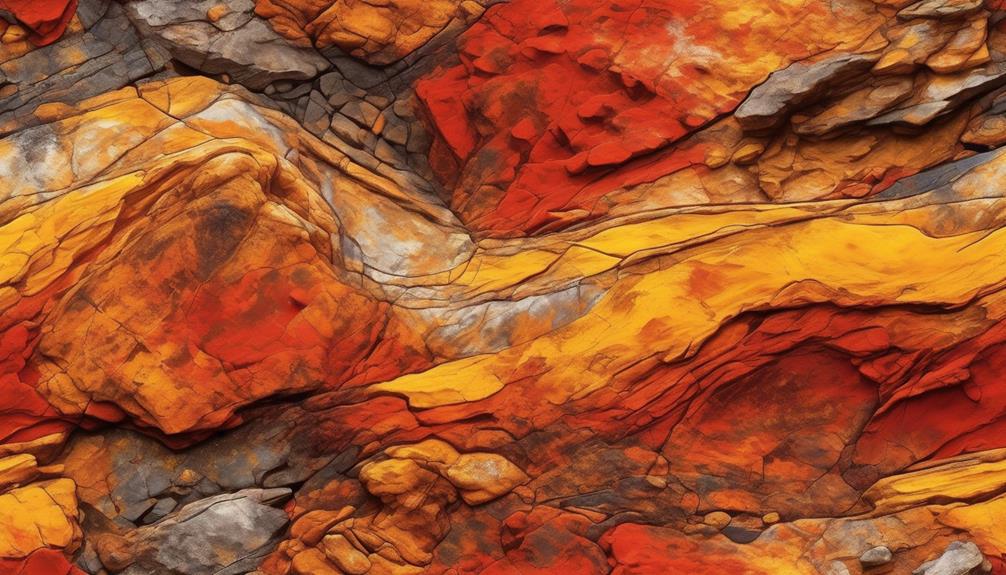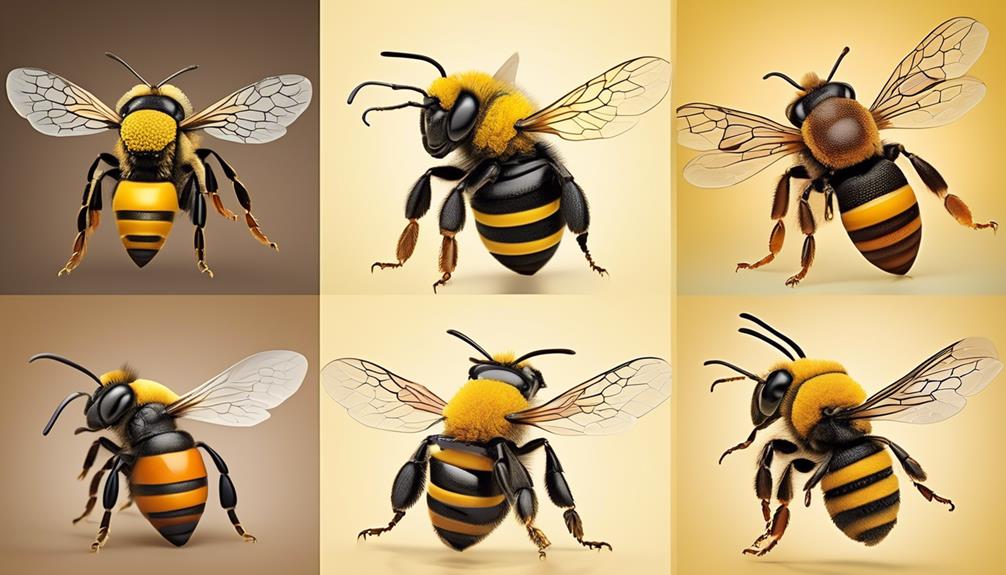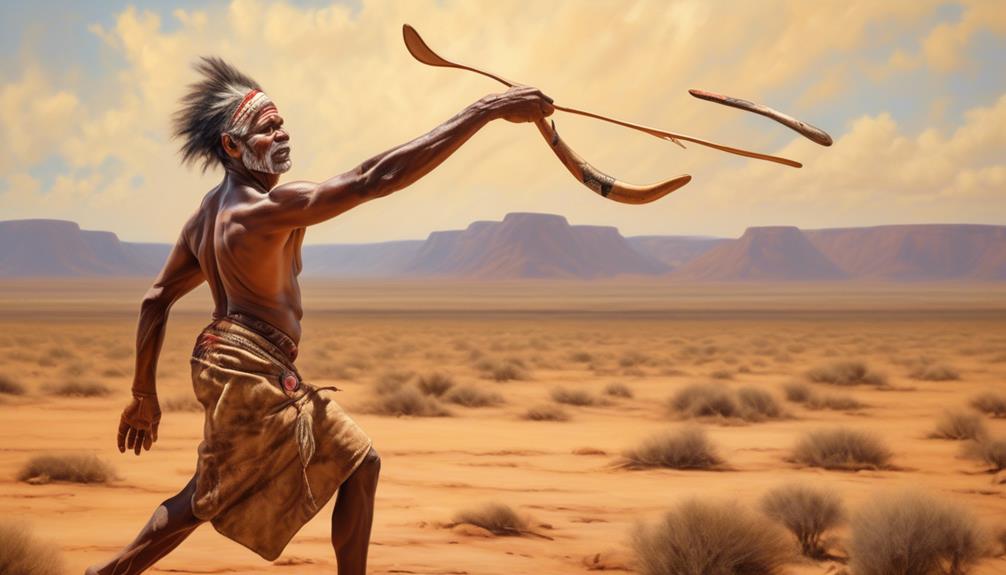In the ancient canvas of Australia’s rocky landscapes, the ochre pigment told a vivid story of the Aboriginal people’s strong connection to their land. The color choice was purposeful, reflecting their rich cultural heritage and deep understanding of the environment.
As we explore the significance of this color in Aboriginal rock art, we'll uncover the techniques used to extract it from the earth, the symbolism imbued in each stroke, and the ongoing efforts to preserve these timeless masterpieces.
Join us in unraveling the vibrant hues that have stood the test of time and continue to captivate the imagination.
Key Takeaways
- Aboriginal Australians commonly used ochre to create rock art thousands of years ago.
- Ochre is a natural earth pigment ranging in color from yellow to deep red.
- Ochre held spiritual and symbolic meanings, connecting artists and communities to the land and ancestors.
- Techniques for obtaining natural pigments involved grinding rocks and minerals to create different color variations.
Origins of Ochre Usage
The origins of ochre usage can be traced back to ancient Aboriginal Australian cultures, where it played a significant role in their artistic and ceremonial practices. Ochre, a natural earth pigment ranging in color from yellow to deep red, was a vital component in the creation of prehistoric traditions and ancient pigments. For thousands of years, Aboriginal Australians used ochre as a medium for rock art, body painting, and other forms of visual expression. The significance of ochre in their culture extended beyond its practical applications; it held spiritual and symbolic meanings, connecting the artists and their communities to the land and their ancestors.
The use of ochre in Aboriginal Australian culture exemplifies the deep reverence for tradition and connection to the land. It wasn't merely a tool for artistic expression, but a symbol of cultural continuity and spiritual significance. The careful selection and preparation of ochre, along with its application in ceremonial contexts, underscore the reverence and respect for ancient practices.
Understanding the origins of ochre usage provides insight into the rich cultural heritage and artistic traditions of Aboriginal Australian communities, enriching our appreciation of their history and legacy.
Significance in Aboriginal Culture
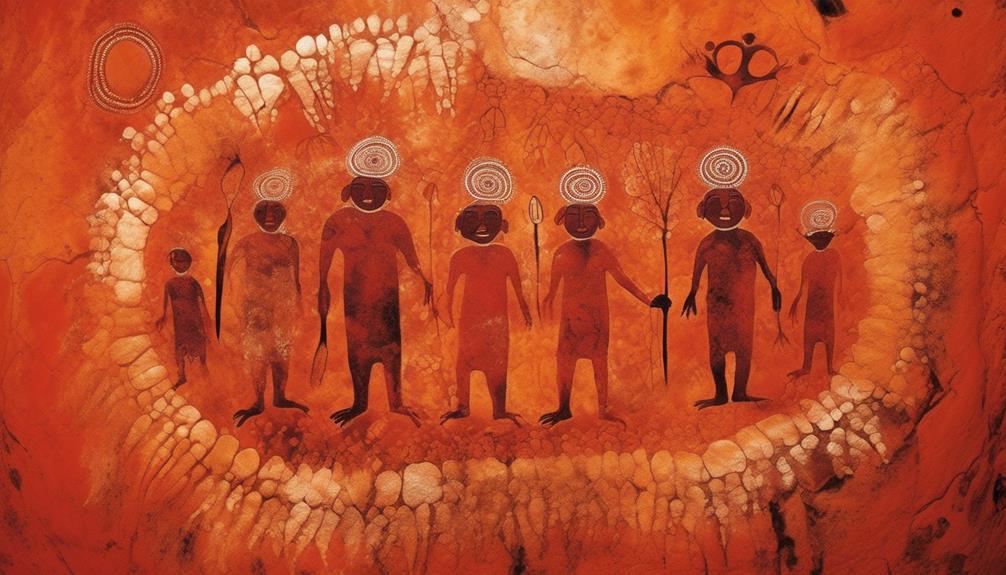
Originating from the ancient Aboriginal Australian cultures, the significance of ochre in their artistic and ceremonial practices reflects a deep connection to their traditions and spiritual beliefs.
- Cultural Significance: Ochre holds immense cultural significance for Aboriginal Australians, symbolizing the earth, the ancestors, and the sacred connection to the land. It's integral to their cultural identity and plays a vital role in their ceremonies and rituals, fostering a profound sense of belonging and heritage.
- Traditional Practices: The traditional use of ochre in art and ceremonies has been passed down through generations, carrying with it the knowledge and stories of the past. This practice not only preserves their cultural heritage but also serves as a means of educating and connecting the younger generations to their ancestral traditions.
- Spiritual Connection: Ochre is intertwined with the spiritual beliefs of Aboriginal Australians, representing the spiritual realm and the ancestral beings. Its use in art and ceremonies is a way of honoring their spiritual connection to the land and the stories of creation, fostering a sense of reverence and awe for their cultural and spiritual heritage.
Techniques for Obtaining Natural Pigments
Obtaining natural pigments from the earth and minerals involves a variety of techniques used by Aboriginal Australians for their rock art and ceremonial practices. The grinding process was a common method employed to extract pigments from rocks and minerals. This involved using a hard, flat stone to grind the raw material into a fine powder, which could then be mixed with a binding agent such as water or animal fat to create a paint-like substance.
Through this meticulous process, different color variations could be achieved by sourcing pigments from various mineral deposits found in different geographical locations. For instance, red ochre was often obtained from iron oxide-rich deposits, while white pigment was derived from kaolin or gypsum.
The techniques for obtaining natural pigments weren't only practical but also deeply tied to the cultural significance of the colors used. Understanding these techniques provides insight into the resourcefulness and artistic ingenuity of Aboriginal Australians, highlighting the depth of their connection to the land and their traditional practices.
Symbolism and Meaning in Rock Art
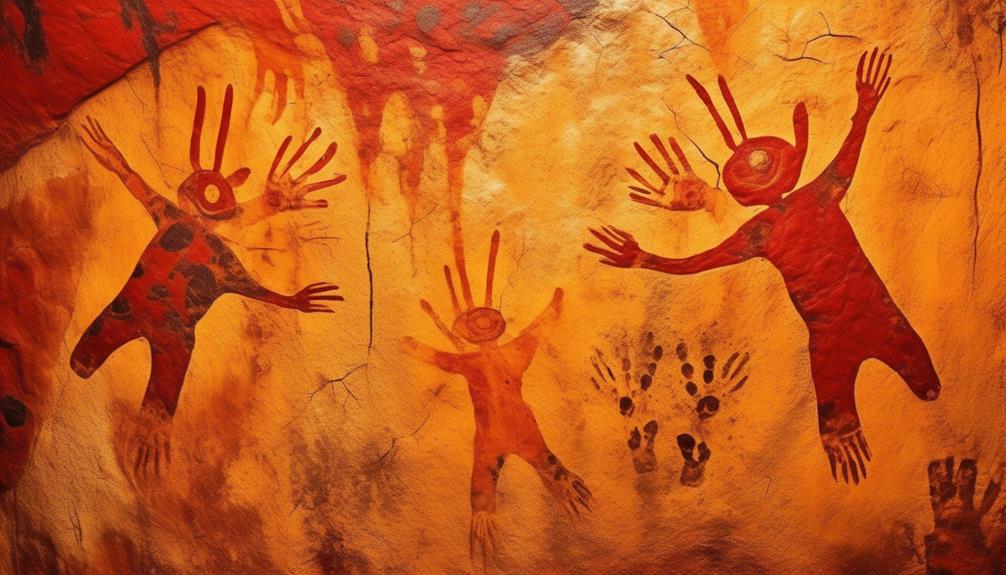
Exploring the symbolism and meaning behind Aboriginal Australian rock art provides valuable insights into the cultural and spiritual significance of these ancient artworks. The symbolism and spirituality depicted in the rock art offer a window into the beliefs and practices of the Aboriginal people, allowing us to appreciate their deep connection to the land and the spiritual world.
When delving into the cultural interpretations and meanings of rock art, several key insights emerge:
- Connection to Ancestral Spirits: Many rock art motifs are believed to represent ancestral beings and spirits, illustrating the Aboriginal people's reverence for their ancestors and their enduring presence in the natural world.
- Narratives of Creation and Dreamtime: The imagery in rock art often conveys stories of the Dreamtime, the mythical era when the land, animals, and people were shaped by ancestral beings. These narratives are crucial to understanding Aboriginal cosmology and the origins of their cultural identity.
- Sacred Landscapes: Rock art is frequently located in sites of spiritual significance, indicating the importance of specific landscapes and natural features in Aboriginal rituals and belief systems.
Through these cultural interpretations and meanings, the rock art serves as a tangible link to the rich spiritual heritage of the Aboriginal people, inviting us to appreciate and respect their profound connection to the land and their ancestral traditions.
Preservation and Conservation Efforts
Efforts to preserve and conserve Aboriginal Australian rock art have been ongoing for decades, aiming to protect these invaluable cultural treasures for future generations. The cultural significance of these ancient artworks cannot be overstated, making preservation a top priority. Traditional techniques, combined with modern conservation efforts, are being employed to ensure the longevity of these priceless artifacts.
| Preservation Methods | Conservation Efforts |
|---|---|
| Site Monitoring | Use of Protective Coatings |
| Controlled Tourism | Digital Documentation |
| Education and Awareness | Environmental Management |
Site monitoring involves regular checks to identify and address any signs of deterioration or damage to the rock art. Controlled tourism aims to minimize the impact of visitors on these delicate sites. Educating the public about the significance of these artworks helps garner support for preservation efforts. Additionally, traditional rock art conservation methods, such as the use of protective coatings, are being combined with modern techniques. Digital documentation ensures that detailed records of the rock art are preserved for future research and conservation efforts. Environmental management practices seek to maintain the natural surroundings of the rock art sites, further aiding in their long-term preservation.
Frequently Asked Questions
What Specific Types of Rocks or Minerals Were Commonly Used to Create Red Ochre Pigment for Rock Art?
We commonly used hematite and goethite, both iron oxide minerals, to create red ochre pigment for Aboriginal Australian rock art. These types of rocks were ground into a fine powder and mixed with water or animal fat to form the pigment.
This red ochre pigment was then applied to rock surfaces using various rock art techniques, showcasing the rich cultural and artistic traditions of Aboriginal Australians.
How Did Aboriginal Australians Store and Transport Ochre Pigment for Rock Art Creation?
Ochre storage and pigment transportation were crucial for rock art preservation. Ancient techniques involved using natural materials like shells, bark, or animal hides to store and carry the ochre pigment. This allowed Aboriginal Australians to create and maintain their rock art, showcasing their cultural heritage for thousands of years.
These methods demonstrate the resourcefulness and ingenuity of Indigenous peoples in preserving their artistic traditions.
Were There Any Variations in the Colors of Ochre Used for Rock Art, or Was Red the Most Commonly Used Color?
Variations in ochre color were indeed used for rock art by Aboriginal Australians. Different shades of red, yellow, brown, and white ochre were commonly utilized, reflecting the rich diversity of available pigment sources.
This variation in color not only added visual interest to the rock art but also held symbolic significance, representing different aspects of the natural and spiritual worlds.
Such use of varied ochre colors showcases the depth and complexity of Aboriginal artistic expression.
Did Different Aboriginal Groups Have Their Own Unique Methods for Creating and Applying Ochre Pigment in Rock Art?
Different techniques and application methods were utilized by various Aboriginal groups for creating and applying ochre pigment in rock art. Each group had its own unique approach, resulting in diverse styles and patterns across different regions.
The methods ranged from finger painting to using brushes made from natural materials, showcasing the rich artistic traditions and cultural diversity of Aboriginal Australians.
Is There Evidence of Trade or Exchange of Ochre Pigment Between Different Aboriginal Communities for Rock Art Creation?
There's evidence of trade and cultural exchange between different Aboriginal communities for rock art creation.
Various ochre pigments were likely exchanged through trade networks, indicating a form of cultural interaction and resource sharing.
This exchange suggests a level of interconnectedness and cooperation among Aboriginal groups in obtaining materials for their art.
The evidence of trade and exchange of ochre pigment highlights the rich cultural connections and the significance of ochre in rock art creation.
Conclusion
In conclusion, the use of ochre by Aboriginal Australians in rock art has a rich and deep history. It's fascinating to note that over 100,000 rock art sites have been documented across Australia, featuring a wide range of ochre colors and intricate designs.
The significance of ochre in Aboriginal culture and the techniques used to obtain natural pigments provide a glimpse into the creativity and resourcefulness of ancient Indigenous communities.
Mary is a passionate writer who brings creativity and a fresh perspective to our team. Her words have the power to captivate and inspire, making her an essential contributor to our content. Mary’s commitment to storytelling and dedication to promoting Indigenous culture ensures that her work touches the hearts of our readers. We’re fortunate to have her as part of our team.
